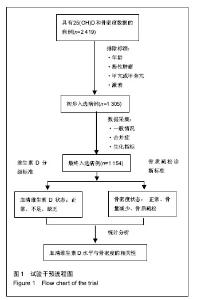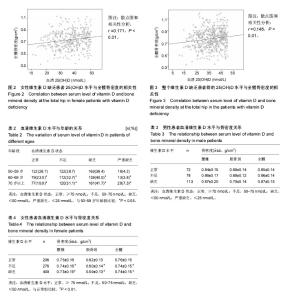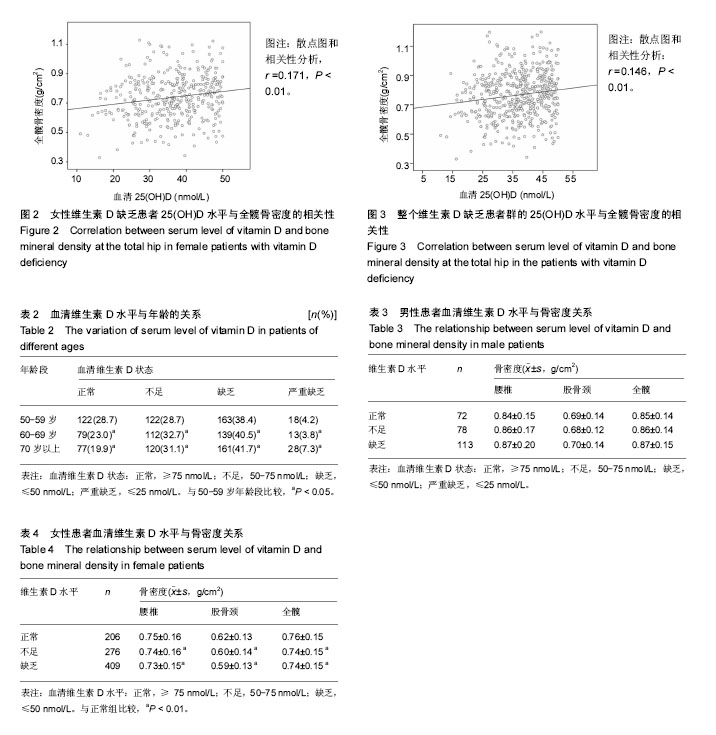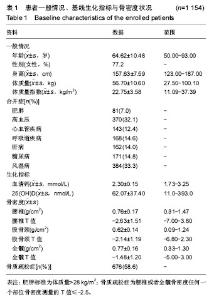Chinese Journal of Tissue Engineering Research ›› 2017, Vol. 21 ›› Issue (28): 4448-4453.doi: 10.3969/j.issn.2095-4344.2017.28.004
Previous Articles Next Articles
Association of serum vitamin D with bone mineral density of middle-aged and elderly patients in southern China
Zhang Liang-ming, Yang Yang, Chen Zhen-xiang, He Tian-wei, He Lei, Liu Bin, Rong Li-min
- Department of Spine Surgery, the Third Affiliated Hospital of Sun Yat-Sen University, Guangzhou 510630, Guangdong Province, China
-
Revised:2017-09-08Online:2017-10-08Published:2017-11-10 -
Contact:Rong Li-min, M.D., Professor, Chief physician, Doctoral supervisor, Department of Spine Surgery, the Third Affiliated Hospital of Sun Yat-Sen University, Guangzhou 510630, Guangdong Province, China -
About author:Zhang Liang-ming, M.D., Attending physician, Department of Spine Surgery, the Third Affiliated Hospital of Sun Yat-Sen University, Guangzhou 510630, Guangdong Province, China -
Supported by:the National Natural Science Foundation of China, No. 81301524 and 81472122; the Natural Science Foundation of Guangdong Province, No. S2013040015484; the Fundamental Research Fund for Universities-Young Teachers Cultivation Project of Sun Yat-Sen University, No. 15ykpy23
CLC Number:
Cite this article
Zhang Liang-ming, Yang Yang, Chen Zhen-xiang, He Tian-wei, He Lei, Liu Bin, Rong Li-min. Association of serum vitamin D with bone mineral density of middle-aged and elderly patients in southern China[J]. Chinese Journal of Tissue Engineering Research, 2017, 21(28): 4448-4453.
share this article

2.1 患者的一般情况 研究共纳入1 154例患者(图1),其中男性263例,女性891例,年龄(64.62±10.48)岁,平均血清25(OH)D水平分别为男性(61.57±38.57) nmol/L和女性(63.78±33.15) nmol/L相比差异无显著性意义(P=0.396);平均骨密度为男性腰椎(0.86±0.18) g/cm2和女性腰椎(0.74±0.16) g/cm2,差异有显著性意义(P < 0.01);男性全髋(0.86±0.14) g/cm2和女性全髋(0.75±0.15) g/cm2,差异有显著性意义(P < 0.01)。患者身高、体质量、体质量指数及合并症情况见表1。"


2.2 血清维生素D水平与年龄关系 1 154例患者按照年龄分为50-59岁、60-69岁和70岁以上年龄段3组。随着年龄增大,3组患者的血25(OH)D水平逐渐降低,分别为(67.76± 45.57),(60.83±31.10)和(56.92±31.29) nmol/L (P < 0.01);维生素D不足或缺乏的比例则逐渐升高,比例分别为71.3%,77.0%和80.1%(表2,P < 0.05)。 2.3 血清维生素D水平与骨密度关系 性别差异:按照维生素D水平,把患者分为正常、不足和缺乏3组。男性和女性患者中,3组不同维生素D状态患者的骨密度数值差异无显著性意义(表3,4)。 在缺乏维生素D的[25(OH)D≤50 nmol/L]患者中,男性患者25(OH)D水平与腰椎骨、股骨颈和全髋骨密度无关;然而,女性患者25(OH)D水平与腰椎骨、股骨颈和全髋骨密度都呈显著正相关(r =0.105,0.135,0.171,P < 0.01)。维生素D缺乏的女性患者25(OH)D水平与全髋骨密度的相关性最高,其散点图以及相关性见图2。 总体人群:患者总体人群的血清25(OH)D水平与腰椎骨密度无相关性,但与股骨颈(r=0.09,P < 0.01)和全髋骨密度(r=0.08,P < 0.01)存在弱正相关性。在缺乏维生素D的(25(OH)D ≤ 50 nmol/L)患者中,25(OH)D水平与腰椎骨、股骨颈和全髋骨密都呈显著正相关(r =0.117,0.120,0.146,P < 0.01)。整个维生素D缺乏患者群的25(OH)D水平与全髋骨密度的相关性最高,其散点图以及相关性见图3。"

| [1] Holick MF. Vitamin D deficiency. N Engl J Med. 2007;357(3): 266-281. [2] Holick MF. The vitamin D deficiency pandemic: approaches for diagnosis, treatment and prevention. Rev Endocr Metab Disord. 2017;18(2):153-165. [3] 中华医学会骨质疏松和骨矿盐疾病分会.原发性骨质疏松症诊治指南(2011年)[J].中华骨质疏松和骨矿盐疾病杂志, 2011, 4(1):2-17. [4] 邱贵兴,裴福兴,胡侦明,等.中国骨质疏松性骨折诊疗指南(骨质疏松性骨折诊断及治疗原则)[J].中华骨与关节外科杂志, 2015, 8(5):371-374. [5] Nguyen HT, von Schoultz B, Nguyen TV, et al. Vitamin D deficiency in northern Vietnam: prevalence, risk factors and associations with bone mineral density. Bone. 2012;51(6): 1029-1034. [6] Choi SW, Kweon SS, Choi JS, et al. The association between vitamin D and parathyroid hormone and bone mineral density: the Dong-gu Study. J Bone Miner Metab. 2016;34(5):555-563. [7] Ardawi MSM, Sibiany AM, Bakhsh TM, et al. High prevalence of vitamin D deficiency among healthy Saudi Arabian men: relationship to bone mineral density, parathyroid hormone, bone turnover markers, and lifestyle factors. Osteoporosis Int. 2012;23(2):675-686. [8] Zhen D, Liu L, Guan C, et al. High prevalence of vitamin D deficiency among middle-aged and elderly individuals in northwestern China: its relationship to osteoporosis and lifestyle factors. Bone. 2015;71:1-6. [9] Holick MF. Vitamin D deficiency in 2010: health benefits of vitamin D and sunlight: a D-bate. Nat Rev Endocrinol. 2011; 7(2):73-75. [10] Holick MF, Binkley NC, Bischoff-Ferrari HA, et al. Evaluation, treatment, and prevention of vitamin D deficiency: an Endocrine Society clinical practice guideline. J Clin Endocrinol Metab. 2011;96(7):1911-1930. [11] Assessment of fracture risk and its application to screening for postmenopausal osteoporosis. Report of a WHO Study Group. World Health Organ Tech Rep Ser. 1994;843:1-129. [12] Writing Group for the ISCD Position Development Conference. Diagnosis of osteoporosis in men, premenopausal women, and children. J Clin Densitom. 2004;7(1):17-26. [13] Avenell A, Mak JC, O'Connell D. Vitamin D and vitamin D analogues for preventing fractures in post-menopausal women and older men. Cochrane Database Syst Rev. 2014;4:D227. [14] O'Sullivan F, Laird E, Kelly D, et al. Ambient UVB Dose and Sun Enjoyment Are Important Predictors of Vitamin D Status in an Older Population. J Nutr. 2017;147(5):858-868. [15] Brouwer-Brolsma EM, Vaes AM, van der Zwaluw NL, et al. Relative importance of summer sun exposure, vitamin D intake, and genes to vitamin D status in Dutch older adults: The B-PROOF study. J Steroid Biochem Mol Biol. 2016;164: 168-176. [16] McCarroll K, Beirne A, Casey M, et al. Determinants of 25-hydroxyvitamin D in older Irish adults. Age and Ageing. 2015;44(5):847-853. [17] Haggarty P, Campbell DM, Knox S, et al. Vitamin D in pregnancy at high latitude in Scotland. Br J Nutr. 2013; 109(5):898-905. [18] Lu L, Yu Z, Pan A, et al. Plasma 25-hydroxyvitamin D concentration and metabolic syndrome among middle-aged and elderly Chinese individuals. Diabetes Care. 2009;32(7): 1278-1283. [19] Nakamura K, Kitamura K, Takachi R, et al. Impact of demographic, environmental, and lifestyle factors on vitamin D sufficiency in 9084 Japanese adults. Bone. 2015;74:10-17. [20] Hwang S, Choi HS, Kim KM, et al. Associations between serum 25-hydroxyvitamin D and bone mineral density and proximal femur geometry in Koreans: the Korean National Health and Nutrition Examination Survey (KNHANES) 2008–2009. Osteoporos Int. 2015;26(1):163-171. [21] Lee DY, Jee JH, Cho YY, et al. Serum 25-hydroxyvitamin D cutoffs for functional bone measures in postmenopausal osteoporosis. Osteoporos Int. 2017;28(4):1377-1384. [22] Hansen KE, Johnson RE, Chambers KR, et al. Treatment of vitamin d insufficiency in postmenopausal women: a randomized clinical trial. JAMA Intern Med. 2015;175(10): 1612-1621. [23] Lips P, Hosking D, Lippuner K, et al. The prevalence of vitamin D inadequacy amongst women with osteoporosis: an international epidemiological investigation. Jo Int Med. 2006; 260(3):245-254. [24] Li C, Chen P, Duan X, et al. Bioavailable 25(OH)D but Not Total 25(OH)D Is an Independent Determinant for Bone Mineral Density in Chinese Postmenopausal Women. EBioMedicine. 2017;15:184-192. [25] Bhattoa HP, Nagy E, More C, et al. Prevalence and seasonal variation of hypovitaminosis D and its relationship to bone metabolism in healthy Hungarian men over 50 years of age: the HunMen Study. Osteoporos Int. 2013;24(1):179-186. [26] Wei QS, Chen ZQ, Tan X, et al. Relation of Age, Sex and Bone Mineral Density to Serum 25-Hydroxyvitamin D Levels in Chinese Women and Men. Orthop Surg. 2015;7(4): 343-349. [27] Kanis JA, McCloskey EV, Johansson H, et al. European guidance for the diagnosis and management of osteoporosis in postmenopausal women. Osteoporos Int. 2013;24(1): 23-57. [28] Cheung E, Kung AWC, Tan KCB. Outcomes of applying the NOF, NOGG and Taiwanese guidelines to a cohort of Chinese early postmenopausal women. Clin Endocrinol. 2014;80(2): 200-207. [29] Camacho PM, Petak SM, Binkley N, et al. American association of clinical endocrinologists and american college of endocrinology clinical practice guidelines for the diagnosis and treatment of postmenopausal osteoporosis-2016. Endocr Pract. 2016;22(Suppl 4):1-42. [30] Pourhashem Z, Bayani M, Noreddini H, et al. Prevalence of osteoporosis and its association with serum vitamin D level in older people in Amirkola. North of Iran. Caspian J Intern Med. 2012;3(1):347-353. [31] Raso AA, Navarra SV, Li-Yu J, et al. Survey of vitamin D levels among post-menopausal Filipino women with osteoporosis. Int J Rheum Dis. 2009;12(3):225-229. [32] 张萌萌,李亚刚,刘颖,等.长春市16019例汉族人群骨密度调查及骨质疏松发病率分析[J].中国骨质疏松杂志, 2009,15(7): 534-537. [33] 喻晶,刘佩文,王元英,等.武汉地区11 559名受试者跟骨骨密度检测结果分析[J].中华骨质疏松和骨矿盐疾病杂志, 2010,3(4): 246-250. [34] 杨鸿兵,钱振福,李强,等.北京密云地区19609例正常人群前臂远端骨密度调查及骨质疏松症发病率研究分析[J].中国骨质疏松杂志,2011,17(1):51-55. [35] Chapuy MC, Preziosi P, Maamer M, et al. Prevalence of vitamin D insufficiency in an adult normal population. Osteoporos Int. 1997;7(5):439-443. [36] 汪纯,刘玉娟,肖文金,等.上海地区健康成年人25羟维生素D水平及其与骨密度的关系[J].上海医学,2011,34(3):166-170. [37] 赵海洋,朱建民,张银网.上海地区中老年人维生素D与骨密度之间的相关性调查[J].中国骨质疏松杂志,2014,20(3):292-296. [38] Mezquita-Raya P, Munoz-Torres M, Luna JD, et al. Relation between vitamin D insufficiency, bone density, and bone metabolism in healthy postmenopausal women. J Bone Miner Res. 2001;16(8):1408-1415. |
| [1] | Jiang Huanchang, Zhang Zhaofei, Liang De, Jiang Xiaobing, Yang Xiaodong, Liu Zhixiang. Comparison of advantages between unilateral multidirectional curved and straight vertebroplasty in the treatment of thoracolumbar osteoporotic vertebral compression fracture [J]. Chinese Journal of Tissue Engineering Research, 2022, 26(9): 1407-1411. |
| [2] | Zhu Chan, Han Xuke, Yao Chengjiao, Zhou Qian, Zhang Qiang, Chen Qiu. Human salivary components and osteoporosis/osteopenia [J]. Chinese Journal of Tissue Engineering Research, 2022, 26(9): 1439-1444. |
| [3] | Li Wei, Zhu Hanmin, Wang Xin, Gao Xue, Cui Jing, Liu Yuxin, Huang Shuming. Effect of Zuogui Wan on bone morphogenetic protein 2 signaling pathway in ovariectomized osteoporosis mice [J]. Chinese Journal of Tissue Engineering Research, 2022, 26(8): 1173-1179. |
| [4] | Xiao Hao, Liu Jing, Zhou Jun. Research progress of pulsed electromagnetic field in the treatment of postmenopausal osteoporosis [J]. Chinese Journal of Tissue Engineering Research, 2022, 26(8): 1266-1271. |
| [5] | Gao Yujin, Peng Shuanglin, Ma Zhichao, Lu Shi, Cao Huayue, Wang Lang, Xiao Jingang. Osteogenic ability of adipose stem cells in diabetic osteoporosis mice [J]. Chinese Journal of Tissue Engineering Research, 2022, 26(7): 999-1004. |
| [6] | Peng Kun. Improvement of the treatment effect of osteoporotic fractures: research status and strategy analysis [J]. Chinese Journal of Tissue Engineering Research, 2022, 26(6): 980-984. |
| [7] | Shen Song, Xu Bin. Diffuse distribution of bone cement in percutaneous vertebroplasty reduces the incidence of refracture of adjacent vertebral bodies [J]. Chinese Journal of Tissue Engineering Research, 2022, 26(4): 499-503. |
| [8] | Ou Liang, Kong Dezhong, Xu Daoqing, Ni Jing, Fu Xingqian, Huang Weichen. Comparative clinical efficacy of polymethyl methacrylate and self-solidifying calcium phosphate cement in vertebroplasty: a meta-analysis [J]. Chinese Journal of Tissue Engineering Research, 2022, 26(4): 649-656. |
| [9] | Zhong Yuanming, He Bingkun, Wu Zhuotan, Wu Sixian, Wan Tong, Zhong Xifeng. Meta-analysis of efficacy and safety of Jack kyphoplasty for osteoporotic vertebral compression fractures [J]. Chinese Journal of Tissue Engineering Research, 2022, 26(3): 487-492. |
| [10] | Cai Feng, Yu Bo, Zeng Duo, Chen Qincan, Liao Qi. Cortical bone trajectory in elderly patients with osteoporosis of lumbar disease [J]. Chinese Journal of Tissue Engineering Research, 2022, 26(3): 403-407. |
| [11] | Chen Qiaoling, Bai Yiguang, Liu Kang, Lin Tao, Luo Xuwei. Osteoblast differentiation after conditional knockout of 3-phosphoinositide-dependent protein kinase-1 gene from bone marrow mesenchymal stem cells [J]. Chinese Journal of Tissue Engineering Research, 2022, 26(24): 3785-3789. |
| [12] | He Xingpeng, Zheng Liqin, Li Pengfei, Yue Guiyang, Li Zhihong, Wu Minhui, Lin Ziling. Differences of trabecular microstructure and bone metabolism in two types of kidney-deficiency ovariectomized rats [J]. Chinese Journal of Tissue Engineering Research, 2022, 26(23): 3768-3772. |
| [13] | Yang Liu, Du Jianwei. Measures to reduce the leakage rate of bone cement during vertebral augmentation [J]. Chinese Journal of Tissue Engineering Research, 2022, 26(22): 3598-3601. |
| [14] | Wang Lu, Li Limei, Li Qing, Yang Hongcai, Lan Xiaoqian, Hu Yingrui. Application of polyurethane materials in the repair of osteoporotic bone defects [J]. Chinese Journal of Tissue Engineering Research, 2022, 26(21): 3429-3434. |
| [15] | Cai Zhencun, Gao Zhenhuai, Ren Lixuan, Zhang Zelin. Effect of smoking on bone mineral density in rats [J]. Chinese Journal of Tissue Engineering Research, 2022, 26(20): 3117-3120. |
| Viewed | ||||||
|
Full text |
|
|||||
|
Abstract |
|
|||||

